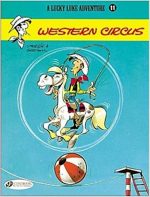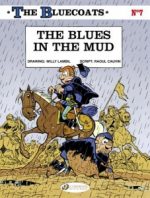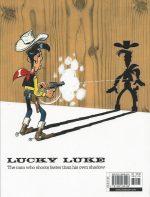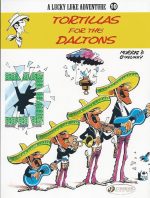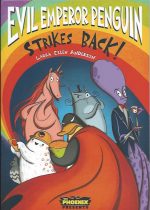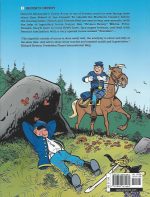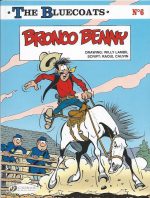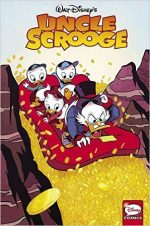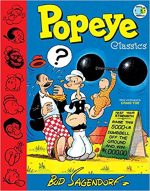
By Bud Sagendorf, edited and designed by Craig Yoe (Yoe Books/IDW)
ISBN: 978-1-61377-557-8Â Â Â Â Â Â Â Â Â Â Â Â Â Â Â Â Â eISBN: 978-1-62302-264-8
There are few comic characters that have entered communal world consciousness, but a grizzled, bluff, uneducated, visually impaired old sailor with a speech impediment is possibly the most well-known of that select bunch.
Elzie Segar had been producing Thimble Theatre since December 19th 1919, but when he introduced a coarse, brusque “sailor man†into the saga of Ham Gravy and Castor Oyl on January 29th 1929, nobody suspected the giddy heights that walk-on would reach…
In 1924 Segar created a second daily strip The 5:15: a surreal domestic comedy featuring weedy commuter and would-be inventor John Sappo and his formidable wife Myrtle which endured – in one form or another – as a topper/footer-feature accompanying the main Sunday page throughout the author’s career. It even survived his untimely death, eventually becoming the trainee-playground of Popeye’s second great stylist Bud Sagendorf.
After Segar’s tragic and far too premature death in 1938, Doc Winner, Tom Sims, Ralph Stein and Bela Zambouly all worked on the strip as the animated features brought Popeye to the entire world. Sadly, none of them had the eccentric flair and raw inventiveness that had put Thimble Theatre at the forefront of cartoon entertainments…
Born in 1915, Forrest “Bud†Sagendorf was barely 17 when his sister – who worked in the Santa Monica art store where Segar bought his supplies – introduced the kid to the master who became his teacher and employer as well as a father-figure. In 1958, Sagendorf took over the strip and all the merchandise design, becoming Popeye’s prime originator…
When Sagendorf took over, his loose, rangy style and breezy scripts brought the strip itself back to the forefront of popularity and made reading it cool and fun all over again. He wrote and drew Popeye in every graphic arena for 24 years. He died in 1994 after which “Underground†cartoonist Bobby London took over.
Bud had been Segar’s assistant and apprentice, and from 1948 onwards he wrote and drew Popeye’s comicbook adventures in a regular monthly title published by America’s king of licensed periodicals, Dell Comics.
When Popeye first appeared, he was a rude, crude brawler: a gambling, cheating, uncivilised ne’er-do-well. He was soon exposed as the ultimate working class hero: raw and rough-hewn, practical, but with an innate, unshakable sense of what’s fair and what’s not, a joker who wanted kids to be themselves – but not necessarily “good†– and someone who took no guff from anyone.
Naturally, as his popularity grew Popeye mellowed somewhat. He was still ready to defend the weak and had absolutely no pretensions or aspirations to rise above his fellows but the shocking sense of dangerous unpredictability and comedic anarchy he initially provided was sorely missed… but not in Sagendorf’s comicbook yarns…
Collected in their entirety in this beguiling full-colour hardback (also available in a digital edition) are the first four 52-page quarterly funnybooks produced by the Young Master spanning February/April 1948 to November 1948/January 1949.
The stunning, seemingly stream-of-consciousness stories are preceded by an effusively appreciative Introduction – ‘Society of Sagendorks’ – by inspired aficionado and historian/publisher Craig Yoe and a fabulous collation of candid photos and letters plus strip proofs, original comicbook art and commissioned paintings, an Activity Book cover and greetings card designs contained in ‘A Bud Sagendorf Scrapbook’.
Popeye‘s fantastic first issue launched in February 1948, with no ads and duo-coloured (black and red) single page strips on the inside front and back covers. The initial instant episode finds mighty muscled, irrepressible “infink†Swee’ Pea enquiring ‘Were there ever any pirates around here?’ before doing a bit of digging, after which the full-coloured fun begins with ‘Shame on You! or Gentlemen Do Not Fight! or You’re a Ruffian, Sir!’
The salty swab earns a lucrative living as an occasional prize-fighter and here upcoming contender Kid Kabagge and his cunning manager Mr. Tillbox use a barrage of psychological tricks to put Popeye off his game. The key component is electing Olive Oyl President of the fake Anti-Fisticuff Society to convince her man to stop being a beastly ruffian and abandon violence. That only works until the fiery frail learns she’s been gulled…
Swee’ Pea then stars in ‘Map Back! Or Back Map!’ as sinister unprincipled villain Sam Snagg tattoos an invisible secret diagram onto the baby’s body but falls foul of the boy’s garrulous guardian when trying to reclaim the kid and divine the location of Spinachovia‘s hidden treasures…
Wrapping up the full-length action is ‘Spinach Revolt’ as Popeye’s pater Poopdeck Pappy kicks up a fuss about constantly having to eat healthy food.
As the first Superman of comics, Popeye was not a comfortable hero to idolise. A brute who thought with his fists and didn’t respect authority, he was uneducated, short-tempered, fickle (when hot tomatoes batted their eyelashes – or thereabouts – at him); an aggressive troublemaker, he wasn’t welcome in polite society… and he wouldn’t want to be.
Time changed Popeye and made him tamer, but the shocking sense of unpredictability, danger and anarchy he initially provided was sorely missed, so in 1936 Segar brought it back again…
A memorable and riotous sequence of Dailies introduced ancient, antisocial crusty reprobate Poopdeck Pappy. The elder mariner was a hard-bitten, grumpy lout quite prepared – even happy – to cheat, steal or smack a woman around if she stepped out of line. He was Popeye’s prodigal dad and once that old goat was firmly established Segar set Olive and her Sailor Man the Herculean task of “Civilizing Poppaâ€. At the time of this tale that’s still very much a work in progress …
Fed up with eating spinach, Pappy hides his meals and steals the wherewithal to secretly subsist on a diet of candy, cakes and sodas. He even inveigles the lad next door into being the mule in his scurrilous scheme but cannot evade the digestive consequences of his acts…
The premiere outing ends with a brace of single pagers detailing how Swee’ Pea deals with persistent salesmen and a day’s fishing before issue #2 commences…
Master moocher Wellington J. Wimpy again has cause to declare ‘Sir! You are a cheapskate!’ before Swee’ Pea and Popeye are swept up in a controversial debate. In ‘That’s What I Yam!” or ‘I Yam! I Yam’ the sailor believes his baby boy tough enough to wander around town unsupervised but has reasons to revise his opinion after the kid vanishes. Moreover, when he does resurface, the tyke is subject to strange transformations and behaviours. It’s as if a class of trainee hypnotists have all been using the kid as a practise subject but forgot to bring him out of his trance afterward…
Pappy stars in ‘Easy Money’, with the greedy reprobate realising how much cash his sterling son earns for each boxing bout. Determined to get on the gravy train too, the oldster shaves off his beard and impersonates Popeye. By the time he catches wise, Pappy has conned Olive and Wimpy into his scheme and set up a punishing bout with a huge purse, so somebody is going to have to fight…
The issue ends with a two-tone short showing the hazards of bathing Swee’ Pea and another full colour back cover gag with a bullying neighbour realising the folly of trying to spank Popeye’s boy…
Popeye #3 leads with an epic 32-page spooky maritime epic as the superstitious sailor reluctantly agrees to transport 250 “ghosk†traps to ghastly, radish – and phantom – infested ‘Ghost Island’: a cunning yarn of mystery and over-zealous imagination starring many cast regulars and preceded by a hilarious map of the route replacing the inside-front cover gag…
Following up is an implausible account of Popeye apparently becoming a violent bully, beating up ordinary citizens in ‘Smash! or You Can Tell She’s My Girl, Because She’s Wearing Two Black Eyes!’ Happily, a doctor at the sailor’s trial is able to diagnose the incredible truth before things go too far, after which Swee’ Pea indulges in too much sugar in the red and black bit and learns the manly way to play with dolls on the colour back cover…
The final inclusion in this outrageous compilation begins with Wimpy up to his old tricks whilst Popeye hunts ducks before another extended odyssey finds the sailor and hangers-on Swee’ Pea, Olive and Wimpy heading West on safari to capture a rare Ipomoea from sagebrush hellhole ‘Dead Valley’…
It’s a grim wilderness Popeye has endured before: an arid inferno no sane man would want to revisit unless a scientist hired him to. Sadly, that’s not the opinion of local bandit boss Dead Valley Joe who assigns all his scurvy gang the task of dissuading or despatching the uppity easterners before they uncover the region’s incredible secret…
Back home again, Olive Oyl receives a surprise ‘Gift from Uncle Ben!’ Sadly, the strange flying beast called a Zoop prefers Swee’ Pea’s company and her warm generosity in donating the beast takes a hard knock when a stranger offers a million dollars for it…
One final brace of Swee’ Pea shorts then sees the wily kid orchestrate free baseball views for his pals before indulging in food politics to win over a stray cat and wrap up in amiable style these jolly, captivating cartoon capers.
There is more than one Popeye. If your first thought on hearing the name is an unintelligible, indomitable white-clad sailor always fighting a great big beardy bloke and mainlining tinned spinach, that’s okay: the animated features have a brilliance and energy of their own (even the later, watered-down anodyne TV versions have some merit) and they are indeed based on the grizzled, crusty, foul-mouthed, bulletproof, golden-hearted old swab who shambled his way into Thimble Theatre and wouldn’t leave. But they are really only the tip of an incredible iceberg of satire, slapstick, virtue, vice and mind-boggling adventure…
There is more than one Popeye. Most of them are pretty good, and some are truly excellent. This book is definitely one of the latter and if you love lunacy, laughter and rollicking adventure you must now read this.
Popeye Classics volume 1 © 2013 Gussoni-Yoe Studio, Inc. All Rights Reserved. Popeye © 2013 King Features Syndicate. ™ Heart Holdings Inc.
